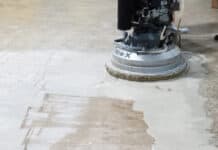 By Tom Griffin
By Tom Griffin
Warehouse floors get a hive of activity. People must work effectively and safely alongside machinery, storage, forklifts, and other vehicles. Warehouse managers often introduce signage, safety precautions, and maintenance schedules to reduce risk and maintain uptime. However, warehouse managers might not realize how much the floor contributes to both safety and efficiency. Tom Griffin, Major Accounts Manager at surface preparation expert National Flooring Equipment can explain the benefits of effective floor preparation in warehouse applications.
Polished concrete covered in clear overlays or epoxy coatings are often popular covering choices because, when well prepared and maintained, these floors can withstand the heavy foot and vehicular traffic required in warehouses. These coatings are durable, easy to maintain, heavy duty, and, depending on the covering, can offer added benefits. Polished concrete, for example, can increase light reflectivity in a space, helping to reduce energy usage, while specialist epoxy-based coatings can better protect the floor from chemicals used in production.
Patch test
Before preparing a new space or renovating an existing warehouse floor, contractors must visit the site to understand its current state. Newly laid concrete requires different equipment and techniques to an older floor with an existing coating, so contractors will only choose the best machinery for the job if they understand the scope of the work and the customer’s requirements.
If working on an existing floor, asking the warehouse manager about previous steps to coat the floor, any issues with moisture, spillages or repairs, and the state of the concrete substrate itself can inform the contractor about what work must be completed.
To understand the state of the concrete and the work required, contractors should conduct a patch test. Surveying the entire space and carrying out moisture and hardness testing is integral to understanding the work required—in large spaces it is unlikely that the concrete was laid in the same way across the space. Once the contractor finds the best space for a test, they can prepare that small area to understand what equipment they’ll need for the work.
Set expectations
Warehouse managers are responsible for maintaining uptime, so construction work should be completed as quickly and efficiently as possible. Good communication and setting clear expectations on both sides will be integral to meeting the deadline and the client’s requirements.
For example, by understanding the customer’s pain points, contractors can plan work to resolve the most pressing issues first. Contractors can also communicate their expectations, so the warehouse manager knows what to remove from the site before work commences.
Contractors should also manage the expectations of the final floor, particularly when the customer has asked for polished concrete. If the concrete is new and pristine, it can be easy to get a perfect polish. The older the concrete, the longer the history, all of which could be highlighted during polishing, meaning that contractors could reveal aggregate or previous imperfections. By speaking to the client about what to expect from the concrete, and demonstrating what the concrete could look like in a patch test, ensures that customers understand what the final floor will look like.
Grinding Warehouse Floors

Once contractors understand the job requirements, they can begin grinding concrete, with dry grinders attached to dust collectors being the common choice in this application. Some warehouses, however, maintain environments where there cannot be any dust, either because of the product being stored or the application, so contractors may prefer to wet grind. No matter the method, contractors should make sure they bring the right scrubbers and sweepers to remove any debris from the side.
Matching the machine to the size of the workplace can also help maintain productivity—larger machines suit larger, open spaces whereas a smaller machine may be better when working in split spaces or when completing the work in stages.
In some cases, customers may require the removal of thick epoxy or preparation to lay a thicker covering. If a grinder cannot complete the work, effectively shot blasting the floor can help achieve the floor texture required for adhesion. While efficient when working with epoxy, shot blasting will leave visible marks on the concrete, so it may not be the best choice when the customer requires polished concrete or a clear covering that will show the substrate underneath.
Know when to stop
The coating that requires removal, the hardness of the concrete, and the required concrete surface profile (CSP) will influence what combination of diamonds, Polycrystalline Diamonds (PCDs) or carbide chips contractors use. They should match the bond to the hardness of the concrete—for example, a harder floor requires soft bond diamonds and softer concrete requires harder diamonds.
It’s important to know when to stop grinding warehouse floors so that the surface has the right texture for the application. If the coating requires a CSP of one, which creates a fairly smooth surface, but the contractor continues to grind until there is a CSP of three or four, where there are more grooves in the material, the coating won’t cover the floor space. Following the coating manufacturer’s instructions will help contractors decide what profile to achieve.
Future maintenance
Once the floor is complete, it’s important to communicate with the warehouse manager about how to maintain its condition. Warehouse floors are made to be durable but cannot withstand everything. For example, while resistant epoxy coatings can protect the concrete from certain chemical spills, the longer the material stays on the floor, the more likely it is to penetrate and negatively impact the concrete. Cleaning the warehouse floor regularly also ensures that it maintains the reflective properties that the customer asked for.
Warehousing is vital to most businesses that manufacture, import, export, or transport goods, so maintaining uptime is integral. While it might not seem to be as important as the technology inside the warehouse, choosing the right floor could help determine how people and vehicles move around the space. Understanding the condition of the concrete in the space, managing expectations, and carefully considering how to prepare the substrate is key to warehouse floor preparation success.





















![[VIDEO] Collect Asset Data at the Speed of Walking a Building](https://facilityexecutive.com/wp-content/uploads/2024/02/maxresdefault-324x160.jpg)